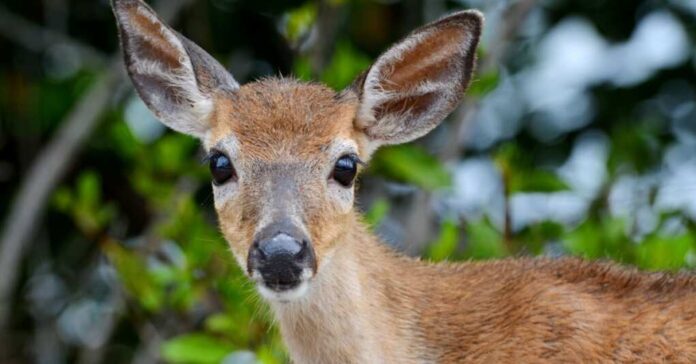
In the stunningly beautiful Florida Keys, a unique and cherished species teeters on the brink of disaster. The Key deer, the smallest subspecies of the North American white-tailed deer, has long captivated residents and visitors alike with its diminutive size and gentle demeanor. But as rising sea levels transform the Florida Keys, this iconic species faces an existential threat. The battle for the Key deer’s survival is more than an environmental issue—it’s a race against time to preserve a vital piece of America’s natural heritage.
The Key deer is found exclusively in the Florida Keys, primarily on Big Pine Key and surrounding islands. Adult Key deer stand just 24 to 32 inches tall at the shoulder, making them a unique and charming part of the local ecosystem. Once hunted nearly to extinction, the Key deer rebounded thanks to intensive conservation efforts, and their population now numbers around 800 to 1,000 individuals. But the specter of climate change looms large over this fragile recovery.
Rising sea levels caused by global warming are encroaching on the low-lying islands the Key deer call home. Much of their habitat is barely above sea level, and even modest increases in sea level can lead to saltwater intrusion into freshwater sources. For the Key deer, freshwater isn’t just a convenience—it’s a necessity. Without it, they cannot survive. Projections suggest that by 2050, much of their habitat could be submerged or rendered uninhabitable due to saltwater contamination.
In addition to the loss of freshwater, the rising seas bring with them increased risks of hurricanes and storm surges, which devastate the deer’s habitat and food sources. As these events become more frequent and severe, the ability of the Key deer to recover diminishes. Compounding the problem, human development and roadways create barriers to movement and increase the risk of vehicle collisions, further threatening the already small population.
Conservationists are racing to address these challenges. Efforts are underway to protect and restore freshwater resources, including creating artificial water stations to provide the deer with a stable drinking supply. Conservation groups are also working to secure undeveloped land and establish wildlife corridors to ensure the deer can move freely between habitats. However, these solutions are temporary fixes in the face of a much larger problem: the relentless rise of the seas.
Some scientists have suggested relocating the Key deer to higher ground or even mainland Florida as a last resort. While relocation could provide a short-term solution, it raises ethical and ecological questions. Key deer are highly adapted to their unique environment, and relocating them could disrupt other ecosystems or cause the deer to lose their distinct characteristics. Furthermore, relocating an entire species is a complex and costly endeavor, fraught with logistical challenges and uncertainty.
The plight of the Key deer serves as a stark reminder of the broader impacts of climate change. Rising sea levels don’t just threaten wildlife—they also endanger communities, economies, and entire ways of life. The Florida Keys, known for their breathtaking beauty and vibrant ecosystems, are on the frontlines of this global crisis. Protecting the Key deer is not just about saving one species; it’s about preserving the interconnected web of life that defines this region.
For visitors to the Florida Keys, the opportunity to see Key deer in the wild is a magical experience—one that future generations might not have if action isn’t taken. By supporting local conservation efforts, advocating for climate solutions, and raising awareness, we can help ensure that these gentle creatures continue to thrive in their natural habitat.
The story of the Key deer is both a warning and a call to action. As sea levels rise and their habitat disappears, the question isn’t just whether we can save the Key deer—it’s whether we can rise to the challenge of protecting the natural world for all species, including our own.















